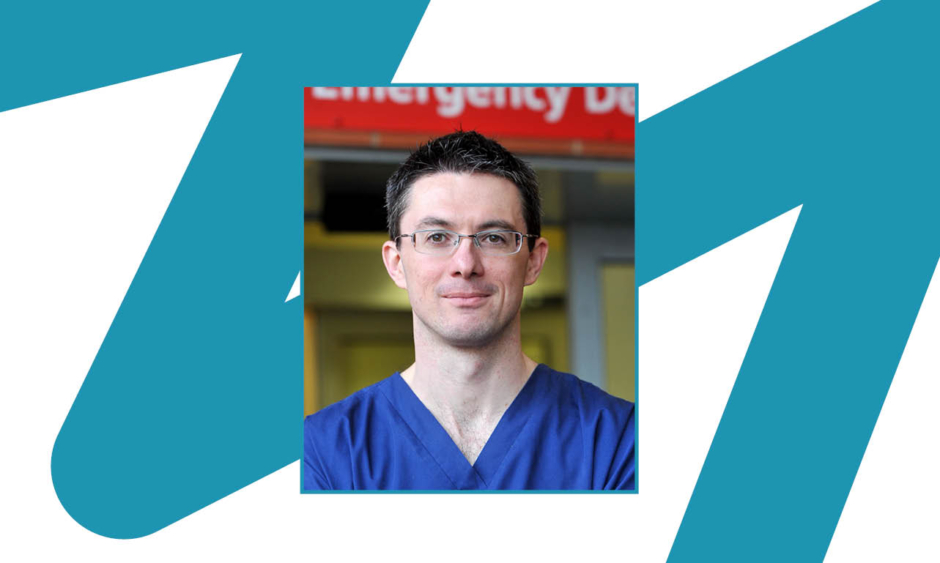Damian Roland | Head of Service, Children’s Emergency Department, Leicester Royal Infirmary, UK; Honorary Professor, Population Health Sciences, University of Leicester, UK
Citation: EMJ. 2023; DOI/10.33590/emj/10309336. https://doi.org/10.33590/emj/10309336.
![]()
What first sparked your interest in working in paediatric medicine, specifically in paediatric emergency medicine?
I’d gone to medical school thinking I was going to be an orthopaedic surgeon. I demonstrated a number of attributes which meant it become quickly apparent this wasn’t where my career was destined. It wasn’t until I did my paediatric attachment as a fourth year student that I found I had an aptitude for spot diagnosis, which is essentially about 95% of acute paediatrics. I was then lucky enough to go to Perth, Western Australia, for my pre-registration house officer (intern) year. I was placed on a 2-month paediatric emergency secondment, and realised that the fast-paced nature of the work, combined with an absence of need for high level technical skill (I just don’t have the patience for surgery), was a perfect vocation for me.
You are an educator who has developed and evaluated educational resources, particularly with regard to digital (eHealth) technologies. Could you speak about a couple of the resources you have worked on, and why these are so important for clinicians?
My PhD involved testing the educational outcomes of an e-learning platform. This was a bespoke website which used video clips of unwell febrile children to teach junior doctors how to risk assess them according to the National Institute for Clinical Excellence (NICE) guidelines. Paediatrics is a visual specialty, and it’s very difficult to teach via text book or in the lecture theatre without audiovisual tools. It is important to note that children relatively infrequently present seriously unwell to emergency care. Paradoxically, while you may think this means that staff may miss serious illness without suitable training, it also means many children with only moderate disease are overtreated, as this will be the most sick child that healthcare professional has ever seen. This overtreatment and overdiagnosis is not good for patients, families, or health systems. Given the reduction in presentations of children during 2020, education and training in normal, moderate, and serious cases is even more important for the next generation of paediatricians. I’m on the lookout all the time for good examples of children with a range of conditions. A child with a classic grunt on my YouTube channel has had 4.7 million views.
You are recognised for using scoring systems in your work, and personally developed the Paediatric Observation Priority Score (POPS). Why do you feel that such systems are an important communication tool in healthcare settings, and how can they improve the care of younger patients? How has your score impacted the field?
I’ve been on a long journey with scoring systems in paediatric emergency care, and while I am a fervent advocate for them, the reasons why I think they work have almost reversed since I started researching them. Ultimately, acute and emergency care paediatrics is a high intensity and high-risk specialty, with large volumes of patients who don’t need treatment but serious consequences result from not treating the small proportion who do. There are too many cognitive biases for clinicians alone to make the right choices all the time, and there need to be systems in place to mitigate for environments where decision-making is impaired.
Conversely, an over-reliance on scores is equally dangerous, as it switches off the Gestalt that is needed in clinical practice. Ultimately, we are still looking for the perfect balance between subjective but flexible human decision-making, and objective but inflexible scores. I hope my work with POPS has demonstrated the need for bespoke emergency care tools; POPS is not a Paediatric Early Warning System (PEWS), and doesn’t really work for ward care, in the same way PEWS isn’t specific enough for emergency care. I hope the need for scoring systems to be cognitive prompts rather than decision making aids has started to percolate through health system thinking.
You recently co-authored a study entitled ‘Time to change the reference ranges of children’s physiological observations in emergency care?’ What were the aims, and did you find out anything surprising?
My colleagues and I for a long time have felt reference ranges for heart and respiratory rates were not specific enough in emergency care. This work, using hundreds of thousands of patient data points, I hope puts to rest the argument about the need to alter the upper limits of heart rate values, especially in preschool children. In our study, for those children below 1 year of age, 23.3% had what NICE considers to be a high-risk heart rate. Interestingly, the respiratory rate values weren’t quite as variable compared to Advanced Paediatric Life Support guidelines as we had predicted.
What do you feel are the unmet needs in paediatric healthcare, and what is the most important thing that should be implemented into the field on a global level?
Without a doubt, inequality, deprivation, and poverty are a leading cause of childhood ill heath, morbidity, and mortality. It is a sobering thought that while we can spend huge sums on health services and systems to treat children, it would probably be better if we could just move more children out of poverty, and concentrate less on expensive hospitals and complex technologies.
You are a strong proponent of using social media in a medical context, and you have over 19,000 followers on Twitter alone. In which ways do you feel yourself, and your readership, benefit from this particular communication tool?
I must confess, I feel, sadly, Twitter is becoming a less powerful tool now that it is increasingly commercialised. However, Twitter has been instrumental for me in developing a large community of a practice and learning network, without which I would have spent far longer making collaborations and researching dead ends. I’ve published a number of papers with colleagues I have never met face-to-face, and have been involved in a few communication strategies which I think have effectively reached the public. The recent invasive group A streptococcal disease surge in the United Kingdom is a good example. I created a short video to help parents understand the risks of this disease, and through Twitter and other mediums, it had over 50,000 views in a week.
You wrote on your Twitter feed recently that the COVID-19 pandemic ‘has accentuated the importance of symptoms over signs’. What is the difference between symptoms and signs, and how do you feel clinicians could better communicate this to the public?
There has always been an issue with ‘Fever Phobia’, a concern that fever alone is harmful even in the absence of other features of illness. COVID-19 has accentuated this, as for 18 months having a fever and/or mild cough would have significant implications for your ability to go to work or go to school. I increasingly recognise that parents and carers become fixated by the symptom their child has (fever, vomiting, diarrhoea), and don’t really concentrate on their behaviours. We have a generation of work to do on helping parents and carers focus on the signs of illness their child has (level of alertness, amount of urine they have produced, the work of their breathing, etc.), rather than symptoms alone.
In early 2022, you co-authored the paper ‘Development, implementation and evaluation of an early warning system improvement programme for children in hospital: the PUMA mixed-methods study’. Could you let us know what this study uncovered, and why an early warning system is so important for your patient cohort?
This was a long piece of work, over 5 years, in which we studied the impact of a focused PEWS implementation programme at four hospitals. We undertook pre-, during, and post-implementation evaluations, using both quantitative and qualitative methods. This approach had not been taken before, and led us to a few unique findings. We were able to develop a bespoke assessment tool that predicted, fairly accurately, the maturity of a hospital in managing the deteriorating child. We were also able to confirm a previously known supposition that the system (staff training, communication tools, reduction of hierarchy) is more important than any one score alone. Finally, we also discovered that demonstrating impact from these systems is very difficult, and across the four hospitals, fluctuations in relevant outcomes (death, ICU transfer) are very small. We have highlighted the need for a broader range of outcome measures to test PEWS systems, and this work is being taken up by the NHS England, Royal College of Paediatrics and Child Health (RCPCH), and Royal College of Nursing (RCN) National PEWS programme.
What advice would you give to those considering a career in paediatric medicine?
Don’t get put off by media reporting and the current challenges all health systems are facing. Paediatrics will challenge you, but it is a highly rewarding career. Try to get some early years experience as a medical student or early years doctors. Rotations in emergency medicine are usually highly rated; while they may be hard from a rota point of view, you will get to see and manage a greater range of patients than on the wards. There are lots of simple things you can do, such as reducing a pulled elbow, that provide almost instant relief to children, and will leave you with a smile inside all day.








